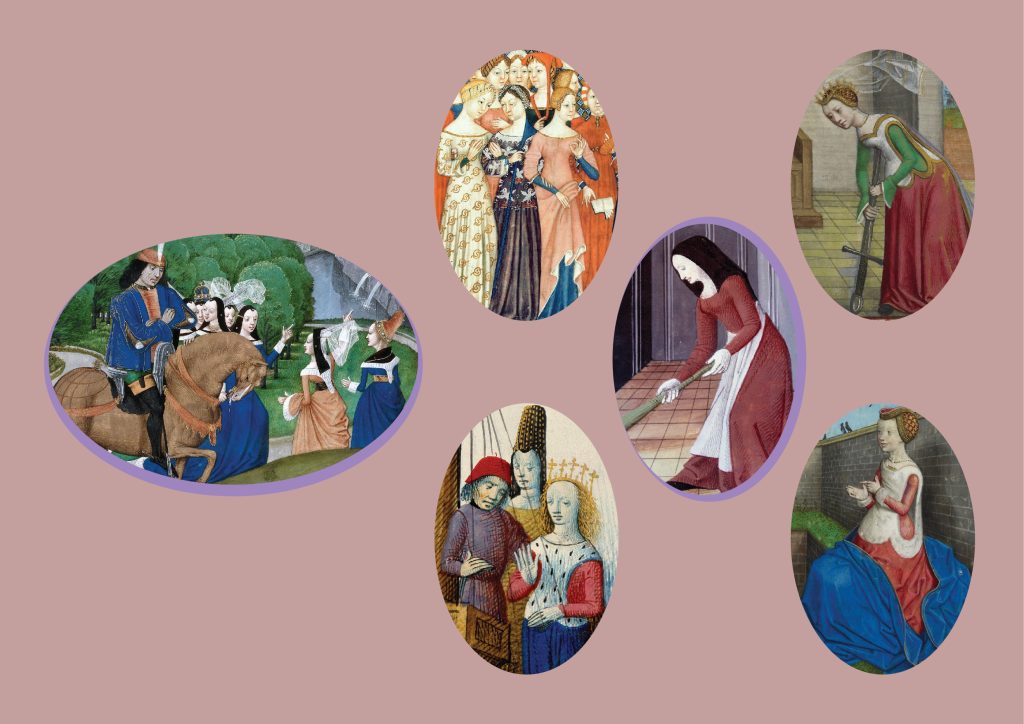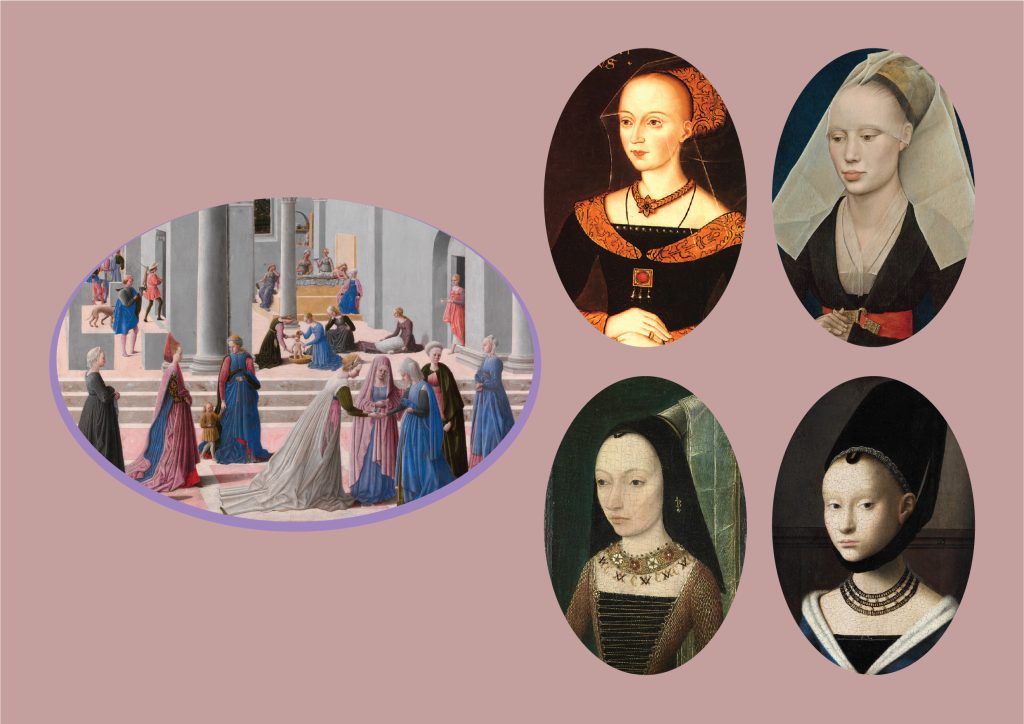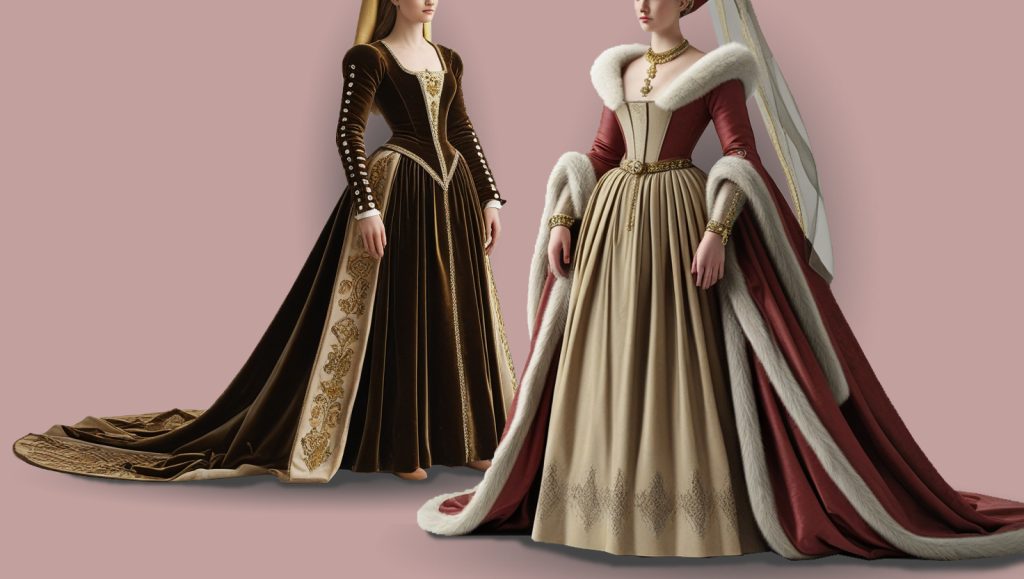Late Medieval Fashion in the Late Medieval Period (1300–1500 CE) underwent significant transformation, reflecting the social and economic and cultural changes of the time. Urbanization, trade expansion, and the rise of the bourgeoisie had a direct impact on the fashions in clothing. Aristocratic fashion grew more extravagant with luxurious fabrics, costly colors, and complex trimmings as symbols of status and power. On the other hand, the middle and working classes‘ clothing remained functional but gradually borrowed details from the upper classes.
Materials and Fabrics
During the Late Medieval Period, fashion was characterized by increasing attention to luxury, opulence, and the availability of a wider range of textiles. With the expansion of trade routes, Europe had access to luxurious textiles from Asia, the Middle East, and North Africa, which contributed to the textile choices for the elite. Textiles, then, became increasingly complex, and clothing was utilized by the nobility as a vehicle for displaying wealth and status.
Primary Textiles
- Silk:
Silk remained the most valuable fabric throughout the Late Medieval Period, particularly for the upper class. It was typically used to create intricate, luxurious gowns, tunics, and decorated trims. Its smoothness and lustrous finish made it a symbol of wealth and high social standing, and it was often reserved for royalty and nobility. - Wool:
Wool was the most common material for the majority, but its utilization evolved. Fulling, which involved washing, stretching, and thickening the wool, created denser, stronger, and more durable fabrics. Wool clothing was more refined because of it, so it was appropriate to be worn by peasants as well as the emerging middle class, especially with advancing wool dyeing skills. - Velvet:
Velvet, a soft and rich fabric constructed of silk or wool, was a favorite among the wealthy. Its rich feel and gleaming surface made it a symbol of extravagance, and it was used liberally for ceremonial dress and court attire. Velvet was paired with other fabrics such as brocade or silk to create even more opulent garments. - Brocade:
Brocade, a luxuriously woven material with silver or gold threads, was the height of affluence and was commonly used by the wealthy during this period. Brocade was often used for robes, mantles, and court gowns and had a dramatic visual effect that was a sign of high status. These luxurious fabrics were often used for special occasions or formal court functions.
Dyeing Techniques
When the Renaissance grew in strength, the Late Medieval period underwent a dyeing revolution and became richer in and more colorful in a greater palette. The ability to make brighter, darker colors like deep reds, blues, greens, and purples was enabled through better techniques of dyeing.
- Cochineal Dye:
The use of cochineal, which is a red dye found in an insect species, gained popularity at this time, especially among the Mediterranean nobility. The colour produced was a beautiful red, which was a fashionable and expensive colour, again demarcating the nobility from the common people. - Natural Dyes:
Prior to the adoption of cochineal, natural plant dyes like woad (blue) and madder (red) were in common usage. The introduction of cochineal provided more durable, brighter color, and in some measure, to the widening differential between the luxury of dress among the elites and the simple color of the peasants’ clothing.
Clothing for Men
- Doublet and Houppelande:
Men’s fashion in the Late Medieval Period saw the favor of the doublet, a tight-fitting garment that descended to the waist from the shoulders. Typically buttoned, it was generally worn over a shirt or tunic and frequently fashioned from luxurious fabrics such as velvet or silk. The houppelande, a flowing and long one, became popular among the nobility. Characterized by its loose fit and wide sleeves, the houppelande tended to be adorned with fur, expensive embroidery, or elaborate trimmings, held to reflect the status of the wearer. - Breeches:
Breeches at this time came from knee-high to more complex types, as the nobles’ versions which were padded to provide a clear cut look. They were generally of wool or linen and ensured comfort as well as functionality. Gore (bits of fabric used as padding) was occasionally used to provide a volume or look factor. - Cloaks and Mantles:
Cloaks and mantles were staples in men’s attire, not only for protection and warmth but also as an indication of wealth and status. The mantle was often lined with costly fur or heavily embroidered. The chaperon, which was a hooded cloak, was very popular among the upper class. It could be draped across the shoulders or styled in many ways, often creating intricate folds and patterns, which signified nobility and conformity of the wearer to the current fashion. - Jerkin and Surcoat:
The jerkin was a sleeveless outerwear that was topped over the doublet, traditionally made of leather, wool, or cloth. The garment emerged as a feature in the everyday attire of gentry and merchants. The surcoat, alternatively worn over the doublet or tunic, was typically accoutred with coats of arms and heraldic devices, predominantly in the noble class and among knights.
Clothing for Women
- Gown and Kirtle:
Women’s fashion during the Late Medieval Period was governed by the gown, which tended to be floor-length and made of superior stuff like silk, velvet, or brocade. The kirtle, the fitted dress above a chemise, remained the woman’s fundamental piece of attire. It produced a fitted appearance and tended to be made from superior materials. The gown itself, especially among the noble women, was richly adorned with delicate details or gold strand, accentuating the affluence and social status of the wearer. - Surcoat:
The surcoat was a gown that was worn over the robe, particularly in formal or ceremonial situations. Made in lighter fabrics, the surcoat would also be cut away at the sides to reveal the gown beneath. The surcoat could also be embroidered with heraldic devices, representing the woman’s family or affiliations. The surcoat was a significant marker of status and prestige. - Headdresses:
Women’s headdresses in the Late Medieval Period grew more intricate and distinctive. The hennin, a tall, conical hat, was especially favored by women of higher social status, with a veil covering the top in certain instances. The other more popular headdress was the fascinator, a smaller trim piece, worn on the side of the head or with a chaperon (a more elaborate headpiece worn also by men). The headdresses were often elaborately decorated with precious metals, pearls, and jewels, both for their aesthetic and symbolic values. - Girdles and Belts:
A popular accessory amongst women fashion, the girdle hung across the waist and occasionally served both as a purposeful and decorative item. Both leather and clothing made up this item, with it sometimes having been decorated using precious gems and metal ornamentation. At times, women adorned their belts by pinning bags or little pieces of decoration, having both proven their wealth as well as handsomeness with accessorizing.

Footwear and Accessories
- Poulaines (Pike Shoes):
The poulaines, the pointed shoes, were a mythical shoe fashion during the Late Medieval period. They had exaggerated, long, pointed toes and were typically leather. The toe could be of any length, and they were typically decorated with jewels or embroidery for the upper classes. - Chopines:
Much as in past centuries, chopines or platform shoes were still stylish in some sections, particularly with women. These were to heighten the appearance of the wearer and were favored by those who held a superior status. Velvet or silk used to manufacture these was also usually topped with jewels. - Gloves and Pouches:
Gloves were an essential fashion accessory for both men and women. Gloves were embroidered and decorated with decorative stitching, being made from fine leather, fabric, or fur. Pouches hung from belts and were used to carry small personal items and were decorated with complex stitching or metalwork to reflect the status of the wearer. - Jewelry:
Jewelry in the Late Medieval Period became more elaborate, with nobility adorning themselves with rings, brooches, necklaces, and pendants of gold and jewels. Religious symbols, coats of arms, and crests were common motifs in jewelry to show the wearer’s nobility or devotion.

Sumptuary Laws:
During the Late Medieval period, sumptuary laws were at the heart of regulating clothes by social class. Sumptuary laws specified what type of material and color of material various social classes could wear, and only affluent materials like silk and velvet were reserved for those in the nobility.
Sumptuary laws were aimed at preserving social order and making sure that people of the lower classes would not imitate members of the elites. In modern times, although such laws have been abolished for centuries, the concept of utilizing clothing to signify social status persists. High fashion and designer clothing are still markers of wealth and distinction today, following the guidelines of sumptuary laws by using exotic materials and creating small productions that signify a wearer’s high status in society.
Religious Influence on Fashion:
Religion continued to exert a great influence on fashion during the Late Medieval period. Clergymen attire, such as cassock and chasuble, was consciously subdued and simple, designed to distinguish the clergymen from other laymen and women. Symbols of religion – crosses and images of saints – were frequently represented in men’s and women’s attire, symbolizing the religiosity of donning it. Religion’s influence remains strong in current fashion, especially in the modest fashion trends that emphasize simplicity and values of religious or cultural importance. Religious symbols also remain in use in modern apparel and accessories, where the cross or other holy imagery serve both as motif and symbol to communicate a wearer’s spirituality or personal faith.
Legacy and Influence
The style of the Late Medieval period set the stage for what was to come in European fashion, particularly influencing the Renaissance. The emphasis on fitted garments and the use of luxurious materials such as velvet and silk set the stage for the excess of the Renaissance, directly influencing modern fashion’s emphasis on refined craftsmanship and high-quality materials. The medieval focus on heraldry, when attire often carried family crests and social status, is also present in fashion today in the current trend towards individualized, monogrammed patterns and high-end labels that are all about individuality and status.
The widening trade during the Late Medieval times, which exposed Europe to exotic materials, is repeated in today’s fashion markets globally, with international trade making it possible for designers to find exotic materials and fabrics from anywhere in the world, continuing the tradition of medieval cultural exchange.
Late Medieval Fashion reflected the dynamic change that marked the Late Medieval Period. As the influence of trade, wealth, and social status grew, so did the sophistication of dress styles, especially among the aristocracy. Meanwhile, the rising middle class adopted stylish yet functional attire, narrowing the gap between luxury and functionality. Almost everything about this period, from customized structuring, elaborate headpieces, and decorative details, paves the way for Renaissance fashion and beyond. The developments of the Late Medieval era continue to affect fashion today, testifying to the lasting impact of this revolutionary phase.


